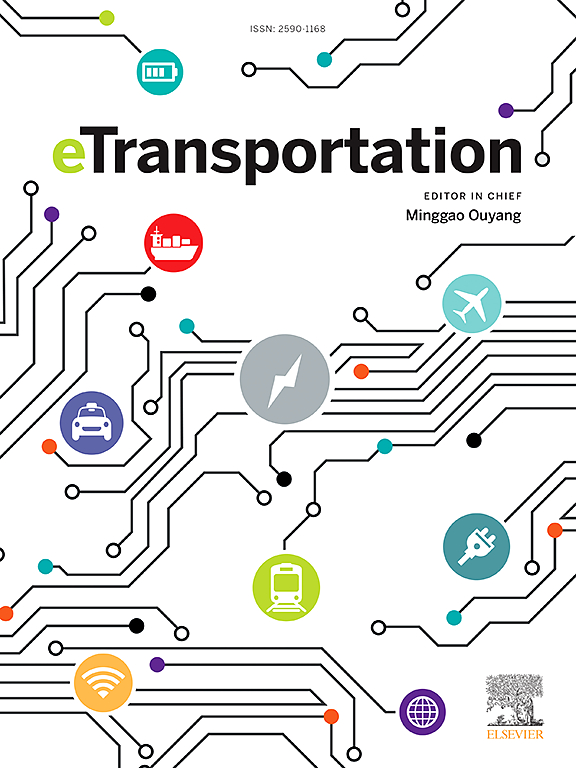基于超声增强层次深度学习框架的LiFePO4电池多状态联合估计
IF 17
1区 工程技术
Q1 ENERGY & FUELS
引用次数: 0
摘要
随着电池储能系统的快速发展和日益复杂,实现全面、精确的电池管理需要从单状态估计向精确的多状态联合估计过渡。然而,由于两个关键因素:平坦的外部电压曲线导致内部状态的弱可观测性和独立估计器无法捕获多状态之间的强耦合,LiFePO4电池的精确多状态联合估计仍然具有挑战性。为了解决这些问题,我们引入超声波来获取电池内部物理和电化学状态的原位和运行中的信息,显著提高了多态可观测性。非线性相关分析表明,超声飞行时间(ToF)和光谱特征与电池状态的相关性比传统外部特征强得多。此外,我们提出了一种带有注意机制的分层深度学习框架,以充分利用多状态之间的相关性来改进联合估计。结果表明,超声特征和层次深度学习框架综合增强了LiFePO4电池的堆芯温度(Tcore)、荷电状态(SoC)和剩余放电时间(RDT)的联合估计。与传统的外部特征和独立估计器相比,该框架的RMSE分别为0.198°C (Tcore)、1.045% (SoC)和208.5 s (RDT), RMSE分别降低了59%、52%和61%。本研究开创性地将超声检测引入到多状态联合估计中,具有精度高、计算复杂度低的特点,在先进的电池管理系统中具有很大的应用潜力。本文章由计算机程序翻译,如有差异,请以英文原文为准。
Ultrasonic enhanced hierarchical deep learning framework for advanced LiFePO4 battery multi-state joint estimation
With the rapid development and increasing complexity of battery storage systems, achieving comprehensive and precise battery management requires transitioning from single-state estimation to accurate multi-state joint estimation. However, accurate multi-state joint estimation for LiFePO4 batteries remains challenging due to two key factors: the flat external voltage curve leads to weak observability of internal states and independent estimators fail to capture the strong coupling between multi-states. To address these issues, we introduce ultrasound to obtain in-situ and in-operando information about the battery's internal physical and electrochemical states, significantly enhancing multi-states observability. Nonlinear correlation analysis reveals that ultrasonic time-of-flight (ToF) and spectral features show much stronger correlations with battery states than traditional external features. Furthermore, we propose a hierarchical deep learning framework with attention mechanisms to fully leverage the correlations between multi-states to improve the joint estimation. The estimation results demonstrate that the ultrasonic features and the hierarchical deep learning framework comprehensively enhance the core temperature (Tcore), state-of-charge (SoC), and remaining discharge time (RDT) joint estimation of LiFePO4 batteries. Compared to the traditional external features and independent estimators, the proposed framework achieves the RMSE of 0.198 °C (Tcore), 1.045 % (SoC), and 208.5 s (RDT), resulting in RMSE reductions of 59 %, 52 %, and 61 %, respectively. This study pioneeringly introduces ultrasonic tests in multi-state joint estimation with high accuracy and low computational complexity, showing great potential in advanced battery management systems.
求助全文
通过发布文献求助,成功后即可免费获取论文全文。
去求助
来源期刊

Etransportation
Engineering-Automotive Engineering
CiteScore
19.80
自引率
12.60%
发文量
57
审稿时长
39 days
期刊介绍:
eTransportation is a scholarly journal that aims to advance knowledge in the field of electric transportation. It focuses on all modes of transportation that utilize electricity as their primary source of energy, including electric vehicles, trains, ships, and aircraft. The journal covers all stages of research, development, and testing of new technologies, systems, and devices related to electrical transportation.
The journal welcomes the use of simulation and analysis tools at the system, transport, or device level. Its primary emphasis is on the study of the electrical and electronic aspects of transportation systems. However, it also considers research on mechanical parts or subsystems of vehicles if there is a clear interaction with electrical or electronic equipment.
Please note that this journal excludes other aspects such as sociological, political, regulatory, or environmental factors from its scope.
 求助内容:
求助内容: 应助结果提醒方式:
应助结果提醒方式:


